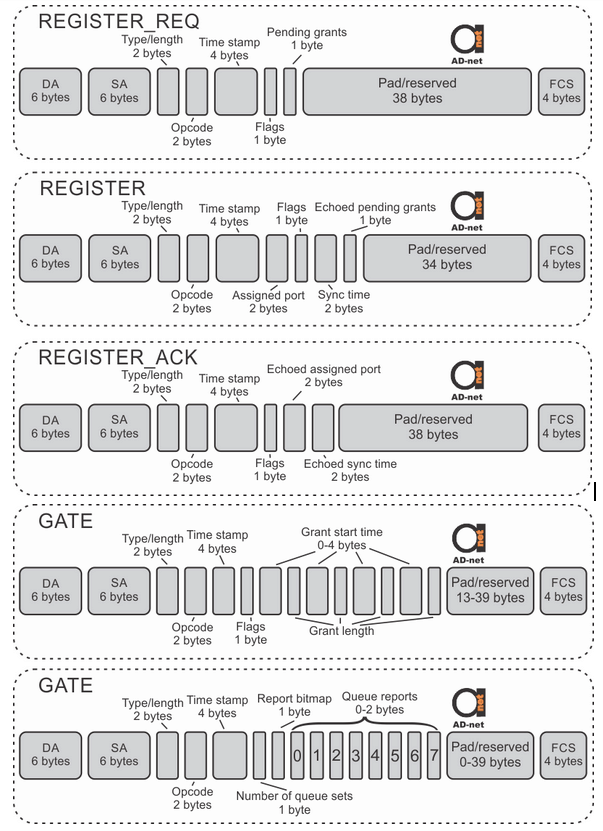EPON is using different technologies for transmitting data downstream and upstream, due to its asymmetric P2MP architecture. Downstream signal is broadcasting encrypted data to all ONUs/ONTs, but ONUs/ONTs just can pick-up data intended for them. Security measure ensure that ONU/ONT cannot decrypt data intended for different ONU/ONT. It is possible, however, to use multicast addressing in downstream direction of EPON for video broadcasting or other media.
Upstream transmission is common for all the ONUs/ONTs in the network. In order to avoid data collision in that single channel, each ONU/ONT has its own time slot when data can be sent without interference from other network participants. Efficient control mechanism for upstream data is called MPCP (MultiPoint Control Protocol) and is using MAC (Medium Access Control) control mechanism.
MPCP is a frame based protocol using five MAC control messages shown in detail in Figure 1. Control messages are:
-
REGISTER_REQ
-
REGISTER
-
REGISTER_ACK
-
GATE
-
REPORT
Each of the messages is having its unique pupose in communication between ONT/ONU and OLT.

is generated by ONU/ONT and sent to OLT for registration or deregistration. It is 64-byte Ethernet frame with message in the Opcode field, flag that identifies type of request and number of grants that ONU/ONT can buffer in the pending grant field.
The OLT is replying with REGISTER message. ONU/ONT is replying with the same parameters in REGISTER_ACK, providing OLT with knowledge that parameters are acknowledged.
Bandwidth is assigned using GATE and REPORT messages. GATE messages are broadcasted downstream from OLT carrying information about upstream bandwidth allocations. One GATE message carries up to four grants for ONUs/ONTs. ONU/ONT replies with REPORT message carrying up to eight queue statuses.
Another use of the GATE message – is the discovery of new ONUs/ONTs in the network. OLT periodically transmits discovery GATE message downstream, carrying information about Discovery Time Window. If new ONU/ONT receives this message, it replies during Discovery Time Window with the REGISTER_REQ message containing its unique MAC address. After OLT registered new ONU/ONT, it replies with REGISTER message waiting for REGISTER_ACK reply so the registration would be complete. GATE message is sent together with REGISTER message to define ONUs/ONTs answer time slot. Example of that is shown in Figure 2.

Figure 2. Registration of an ONU/ONT in discovery process
The MPCP is using REPORT/GATE mechanism for dynamical assignment of upstream bandwidth. Depending on the incoming traffic load and QoS requirements OLT changes upstream bandwidth allocation. Figure 3 shows the bandwidth negotiation between OLT and ONU/ONT. It is done in three steps:
-
First, ONU/ONT sends REPORT message with timestamp and queue status;
-
Then OLT is calculating RTT (Round Trip Time) based on timestamp and sending GATE message with TS, grant start time, and grant length;
-
Finally the ONU updates the local time based on TS and transmits data in the time slot.

Since the EPON is constantly updating technology and capacity is increasing, there is concern of growing energy consumption. Some devices are partially solving this problem by implementing sleep modes for the network equipment, which will only work full power in the need of high-speed communication. It is mainly done for ONUs/ONTs that are in the “asleep but aware” state, waiting to “wake up” anytime.


